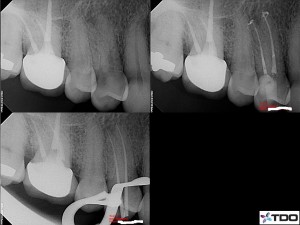One of the instrumentation mantras I like to keep in mind is “take what the tooth gives you”. While we have a wide range of instruments available to clean the root canal system, it is imperative that we use these instruments judiciously. We also have to make an effort not to predetermine our apical, coronal or midroot shaping, but rather allow the anatomy to assist us in creating the ideal shape for a specific root.
Each and every canal I treat is initially prepared with hand instruments. I tend to favor a crown down approach, prebending each file in the apical mm or two. This process allows me to gather information on canal morphology before I begin to use Nickel Titanium instrumentation. I gauge the feeling of resistance and the depth of that resistance using multiple instruments. I also assess the locations of debris on the file. This process can also be repeated using rotary files. This is one of the reasons that an intimate knowledge of your instruments is so vital. Visual inspection of the instruments combined with the knowledge of the diameters of these instruments allows the clinician to create their shape of choice.
Despite my best efforts to expand the coronal and midroot preparation on the following case, the tooth was not receptive to these efforts. In the end, each canal was obturated with an .04 cone, sized to fit the canals, which were each prepared to .216 to patency. This is an extremely small shape for me. However, that is what the canals were giving me. It was barely accepting a prebent 25K file to full working length, the SX orifice opener felt grabby throughout the procedure, and after creating some taper with additional hand instruments, I feel confident that this case was shaped adequately. There is no doubt that I could have created a larger shape, but to what end: transportation, strip perforation, zipping or a separated instrument?
You have to know when to say when. Pushing rotary files usually does not have a good outcome.
